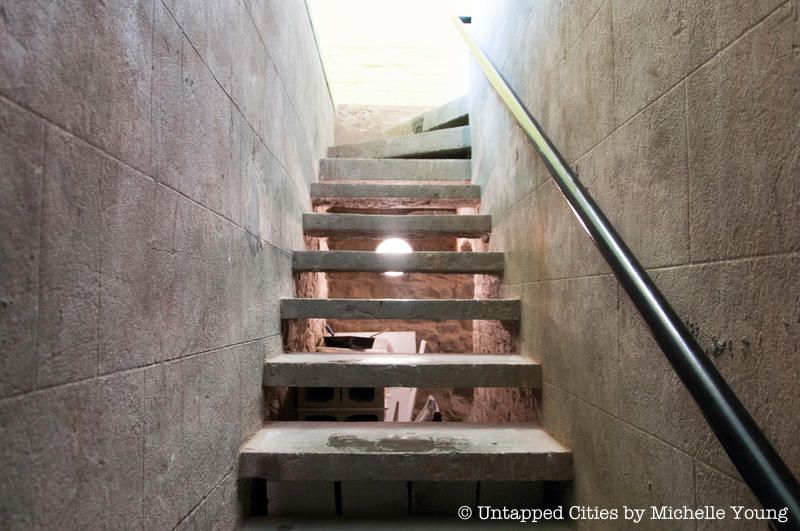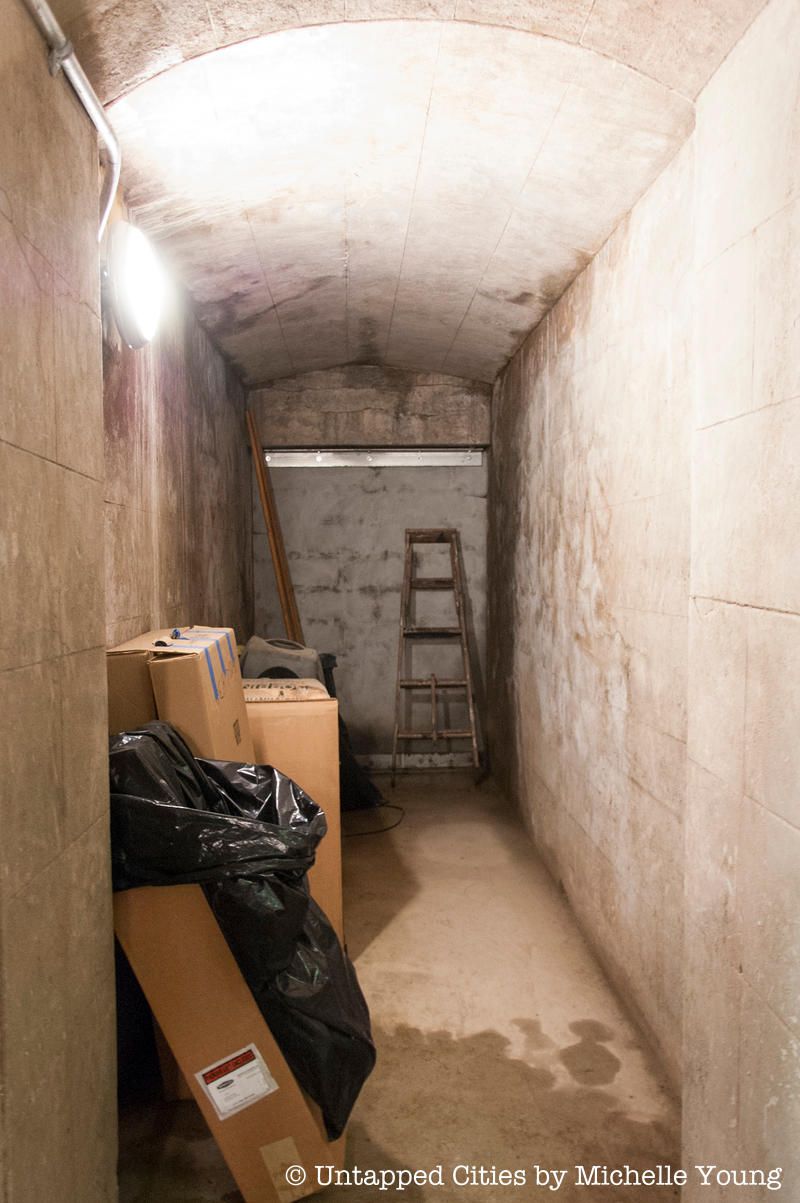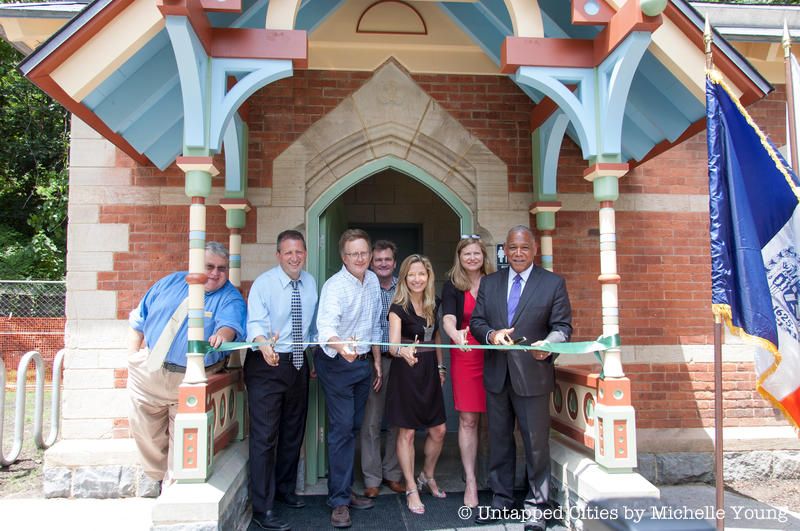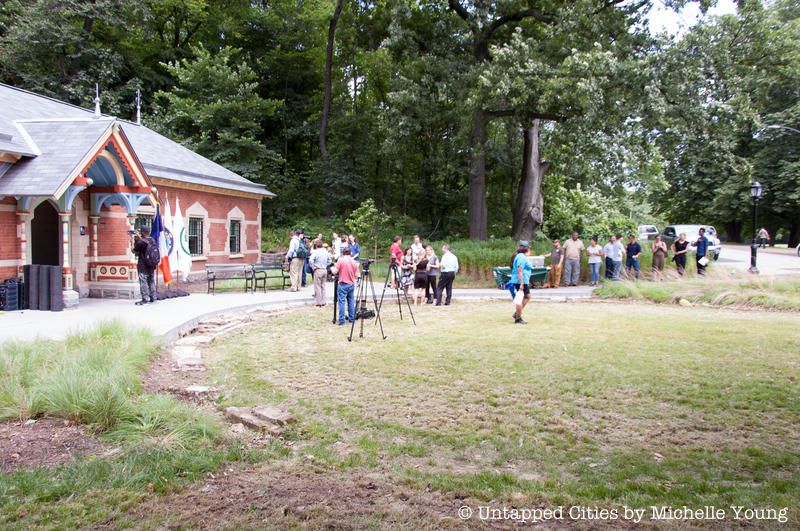See the New Times Square New Year's Eve Ball Up Close
Find out how you can take home a piece of the old New Year's Eve ball!



Yesterday, the Prospect Park Alliance cut the ribbon on the the first composting bathroom in a public park in New York City. The initiative was designed within the Wellhouse Comfort Station, the last remaining building constructed by park designers Frederick Law Olmsted and Calvert Vaux in Prospect Park.
The building, which dates to 1869, originally contained the coal-powered steam engine mechanical pumping system that fed the streams and manmade features of Prospect Park. A brick cistern went fifty feet below ground, with a winding staircase that led to a pump. The Wellhouse building had fallen into disrepair over the course of over a century, rendered obsolete by the connection of Prospect Park to the city’s water system.

The Wellhouse pre-restoration. Photo courtesy Prospect Park Alliance.

The Wellhouse in about 1869. The brick cistern was once topped by a glass and iron structure to allow light to flow down. Photo courtesy Prospect Park Alliance Archives.

Section drawing by Olmsted and Vaux, showing the wellhouse and below ground components. Image courtesy Prospect Park Alliance Archives.
The composting system is designed by the Swedish company Clivis Multrum. The composting toilets in the Wellhouse Comfort Station use only 3 to 6 ounces of water per flush, which is 97% less water than a traditional toilet’s 1.6 gallons. Water from the sinks, floor drains and janitor sinks in the comfort station will go into a new greywater garden. In total, 250,000 gallons of water will be saved per year.

The toilets, which looks pretty much like a normal toilet, mix the small amount of water with a special foamy soap, and everything goes down into one of three large composting tanks. The soap in the toilets is formulated to keep the composting ecosystem running, and help preserve the worms and bacteria in the compost and the health of the plants in the greywater garden next to the comfort station.

A compost toilet in action during flush, with a small amount of water mixed with soap foam

Compost tanks in the basement
Right now, the compost tanks only contain wood chips, but red wriggler worms will be introduced after six months. According to Alden Maddry, the architect behind the restoration and new design, the park will not need to remove solids out of the bins for ten years.

The project included not only major refurbishments to the exterior structure – the portico was recreated and a historic paint scheme was applied, along with the installation of a new roof – significant below ground excavation had to be performed. The staircase to the basement had been covered in concrete, and the lower level was filled with dirt. The room that contains the composting bins had to be dug out as a new space. Today, the connection to the cistern is cinderblocked off, but Maddry believes that some of the original brickwork may still be buried under the dirt – though the iron structure would have deteriorated by this point.



At the ribbon cutting, Sue Donoghue, president of the Prospect Park Alliance, told the audience that “transforming waste into compost increases sustainability and reduces strain on the city’s waste system.” NYC Parks Commissioner Mitchell Silver lauded the efforts to reopen a “long shuttered wellhouse,” and stated that “It may look like a comfort station but it’s so much more. It’s as environmentally friendly as you can get.”

Kathryn Garcia, commission of the NYC Department of Sanitation noted how important this initiative is, even within the composting world: “Using and transforming that technology [of composting] to a comfort station is really revolutionary,” and noted that it is less expensive than creating a new pipe, provides a new option to use less fertilizer in the park, and makes the microbiotic environment healthier.

Composting bathrooms are also already active in the Bronx Zoo and Queens Botanical Gardens, but this is the first one in a New York City public park. The next step with the Wellhouse Comfort Station project is to built a bench out of the remaining bricks at the top of the cistern – bricks Maddry discovered by taking a shovel into the top layer of dirt.


Architect Alden Maddry next to the cistern bricks he uncovered

Next, check out the Top 12 Secrets of Prospect Park and discover 10 Lost of Never Built Structures in Prospect Park.
Subscribe to our newsletter